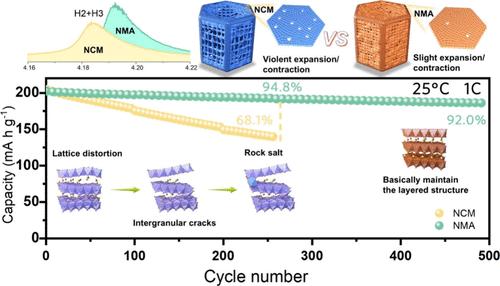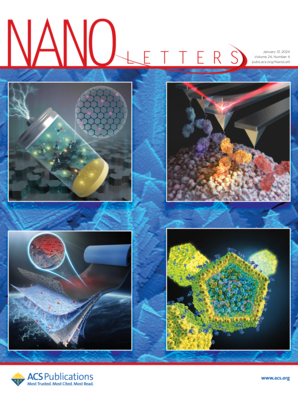Inhibiting Lattice Distortion of Ultrahigh Nickel Co-Free Cathode Material for Lithium-Ion Batteries
IF 9.6
1区 材料科学
Q1 CHEMISTRY, MULTIDISCIPLINARY
引用次数: 0
Abstract
Ultrahigh nickel cathode materials are widely utilized due to their outstanding energy and power densities. However, the presence of cobalt can cause significant lattice distortion during charge and discharge cycles, leading to the loss of active lithium, the formation of lattice cracks, and the emergence of a rock salt phase that hinders lithium-ion transport. Herein, we developed a novel cobalt-free, aluminum-doped cathode material, LiNi0.93Mn0.06Al0.01O2 (NMA), which effectively delays the harmful H2–H3 phase transition, reduces lattice distortion, alleviates stress release, and significantly enhances structural stability. Compared to commercially available Co-rich LiNi0.83Co0.11Mn0.06O2 (NCM) materials, NMA offers a cost reduction of approximately 16% while maintaining comparable capacity. Moreover, NMA exhibits superior rate performance and long-term cycling stability in both half-cell and full-cell configurations. These findings pave the way for the development of cost-effective, high-performance, and durable cobalt-free cathode materials, offering promising potential for future research and commercial applications.

抑制锂离子电池超高镍无钴正极材料晶格畸变的研究
超高镍正极材料因其优异的能量和功率密度而得到广泛应用。然而,在充放电循环过程中,钴的存在会引起明显的晶格畸变,导致活性锂的损失,晶格裂缝的形成,以及阻碍锂离子传输的岩盐相的出现。在此,我们开发了一种新型的无钴、掺铝的阴极材料lini0.93 mn0.06 al0.010 o2 (NMA),该材料有效地延缓了有害的H2-H3相变,减少了晶格畸变,缓解了应力释放,显著提高了结构稳定性。与市售的富钴lini0.83 co0.11 mn0.060 o2 (NCM)材料相比,NMA在保持相当容量的同时降低了约16%的成本。此外,NMA在半电池和全电池配置下均表现出优异的速率性能和长期循环稳定性。这些发现为开发具有成本效益,高性能和耐用的无钴阴极材料铺平了道路,为未来的研究和商业应用提供了广阔的潜力。
本文章由计算机程序翻译,如有差异,请以英文原文为准。
求助全文
约1分钟内获得全文
求助全文
来源期刊

Nano Letters
工程技术-材料科学:综合
CiteScore
16.80
自引率
2.80%
发文量
1182
审稿时长
1.4 months
期刊介绍:
Nano Letters serves as a dynamic platform for promptly disseminating original results in fundamental, applied, and emerging research across all facets of nanoscience and nanotechnology. A pivotal criterion for inclusion within Nano Letters is the convergence of at least two different areas or disciplines, ensuring a rich interdisciplinary scope. The journal is dedicated to fostering exploration in diverse areas, including:
- Experimental and theoretical findings on physical, chemical, and biological phenomena at the nanoscale
- Synthesis, characterization, and processing of organic, inorganic, polymer, and hybrid nanomaterials through physical, chemical, and biological methodologies
- Modeling and simulation of synthetic, assembly, and interaction processes
- Realization of integrated nanostructures and nano-engineered devices exhibiting advanced performance
- Applications of nanoscale materials in living and environmental systems
Nano Letters is committed to advancing and showcasing groundbreaking research that intersects various domains, fostering innovation and collaboration in the ever-evolving field of nanoscience and nanotechnology.
 求助内容:
求助内容: 应助结果提醒方式:
应助结果提醒方式:


